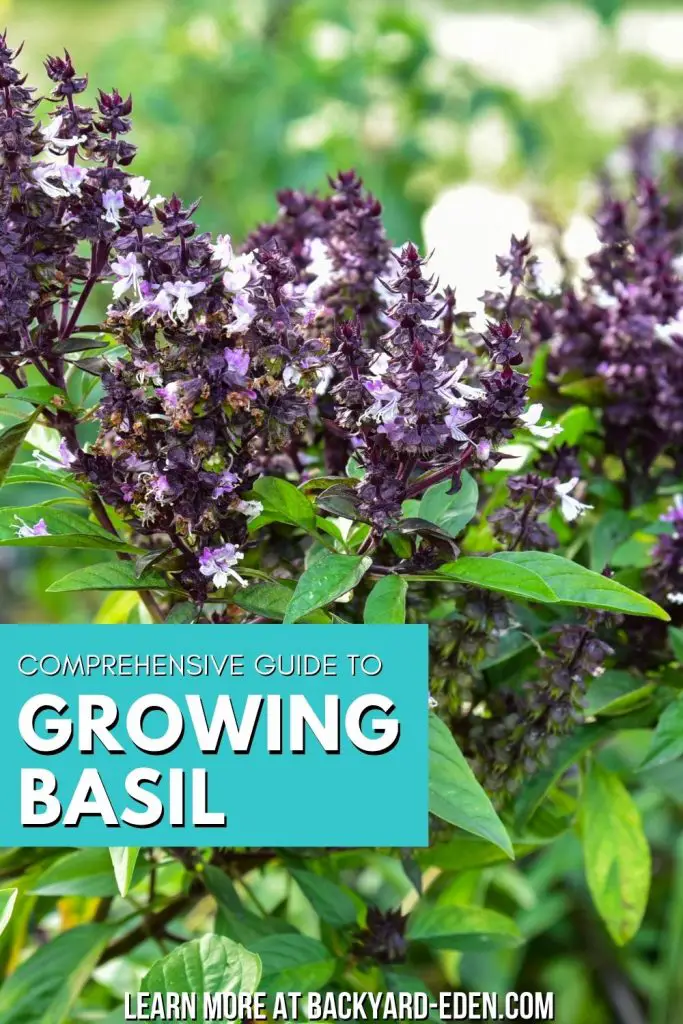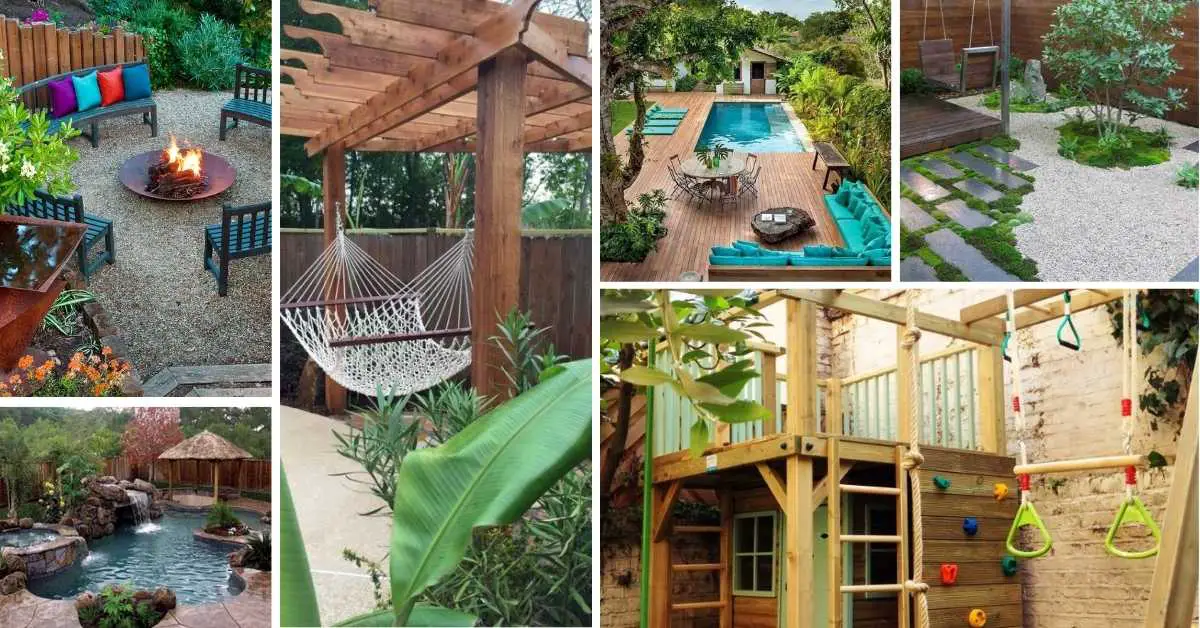Growing Basil: The Complete Guide
Basil is one of the herbs I’m obsessed with growing well. It has a unique aroma that fills your garden and kitchen with fresh, spicy scent you can’t get enough of. Basil lends dishes subtle peppery flavor in all kinds cuisines from Italian to Thai like most healthy herb out there too!
Growing basil isn’t challenging as some edible plants since this tropical native grows outside or inside happy on ground pots- even hydroponic system where harvesting it simple too: just cut off top third bunch stems full leaves before they flower
In fact, basil is so easy to grow and so useful around the house, I think it’s an essential plant for any garden (or windowsill) to have.
You might find yourself overwhelmed with choices when it comes to choosing a plant for your home, but don’t fret! We’re here to help you pick the best one. There are dozens of varieties available and each has its own unique flavors and uses. This guide will walk you through picking what’s perfect for your space so that both people, pets (and plants) can thrive together in harmony.
Basil Varieties
There are a myriad of different kinds of basil, but it all depends on what you want to use it for and your personal preference. Some varieties have stronger flavors than others while some may be sweeter in taste. The type that’s best when making pesto is not necessarily the same as those used medicinally-it really just comes down to figuring out which one suits you better!
Sweet Basil
Sweet Basil, the type most people associate with growing basil. It has large and smooth leaves that are bright green.
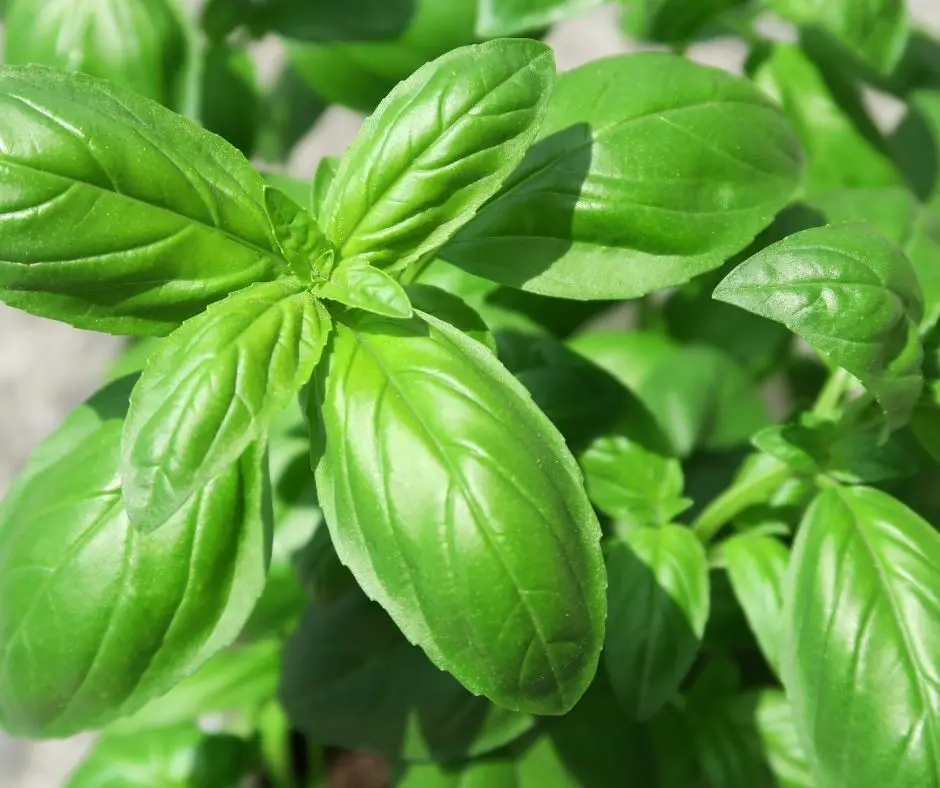
Genovese is one of the most common sweet basil varieties, and it’s often the one you see in your grocery store. If you want to make pesto or eat with tomatoes, this variety is ideal for beginners because it’s not fussy at all!
It has good leaf production and a robust clove-like flavor that can be enjoyed by people who love strong flavors like garlic as well. This type takes 60 days before maturity so plan ahead if possible!
Lettuce Leaf basil is a delicious herb that grows large leaves. They can get as big as your hand and takes about 75 days to mature, reaching 2-feet tall in the process. It has a mild flavor with hints of sweetness!
Thai Basil
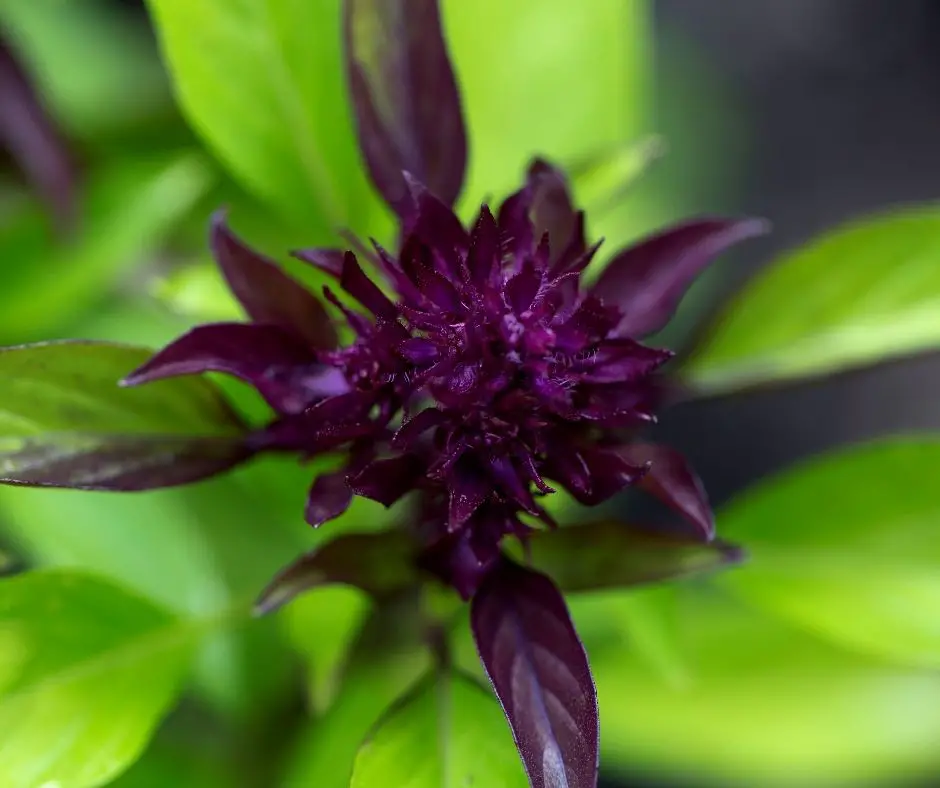
Thai basil is a type of herb often found in Thai cooking. We love growing and using Thai Basil because of the distinct flavor that it has and the fact that it grows like crazy here.
It has a distinct licorice aroma and adds aniseed, clove flavor to dishes. Its leaves are more robust than Genovese basil so it can stand up to the high amounts of heat that come with things like soup making; which makes this variety perfect for those who love authentic cuisine!
There are many different varieties including Persian, Siam Queen, etc., but both mature within 60-90 days and reach 18-24 inches tall – meaning you’ll be able to get your hands on any one easily once they’re ready for purchase!
Purple Basil
There are several types of purple basil, all featuring beautiful dark purple leaves and lilac flowers. The leaves smell sweet and lend nicely to vinaigrettes and salads.
Purple ruffles is a colorful variety with a stronger flavor than you’ll find in sweet basil. As the name implies, it has serrated edges that make for an interesting addition to any garden landscape–whether indoors or out!
Round Midnight grows in dense fragrant violet foliage; at 12-inches tall by 10-inces wide this plant will grow up almost as high as your waist if not given some sort of support system like stakes or trellises
Holy Basil
Holy basil, also known as Tulsi or sacred Basil is a versatile Southeast Asian variety that can be used in various cooking styles. It’s been shown to have numerous health benefits and has a strong camphor scent with matte leaves of red undertone.
At about 12-inches tall it’s one of the smaller varieties so make sure you give this herb room to grow!
Lemon Basil
Lemon basil is an old-fashioned heirloom variety with a delicious, intense lemon flavor. It goes well in recipes for fish and chicken dishes. The plant features narrow leaves which are elongated like most varieties of basil but have the strong scent of lemons rather than typical basils’ minty scent when they’re close to blooming white flowers that last just one day each but produce many seeds from flowering plants often 18 inches tall at maturity (60 – 90 days).
The refreshing taste and aroma makes this type different enough from other types such as Genovese or common sweet Italian herbs you might be more used to growing yourself already so it’s worth trying out!
Greek Basil
If you’re looking to spice up your kitchen garden with something new, then look no further than this variety of basil. Globe Basil is an heirloom variety that originated in Southeast Asia and has a compact size perfect for container growing! It’s only about 8 inches tall so it won’t take up any room on the counter or in those beautiful flower beds around your patio either.
The leaves are small but they pack all sorts of flavor into dishes from pesto sauce to pasta dressings–or try them as well-seasoned garnish over mixed salads too….
The globe basil plant comes bearing tiny green leaves known for their strong flavors like lemon grass and clove spices alike–it’s great added fresh onto almost anything where additional herbal flavor is wanted.
African Blue Basil
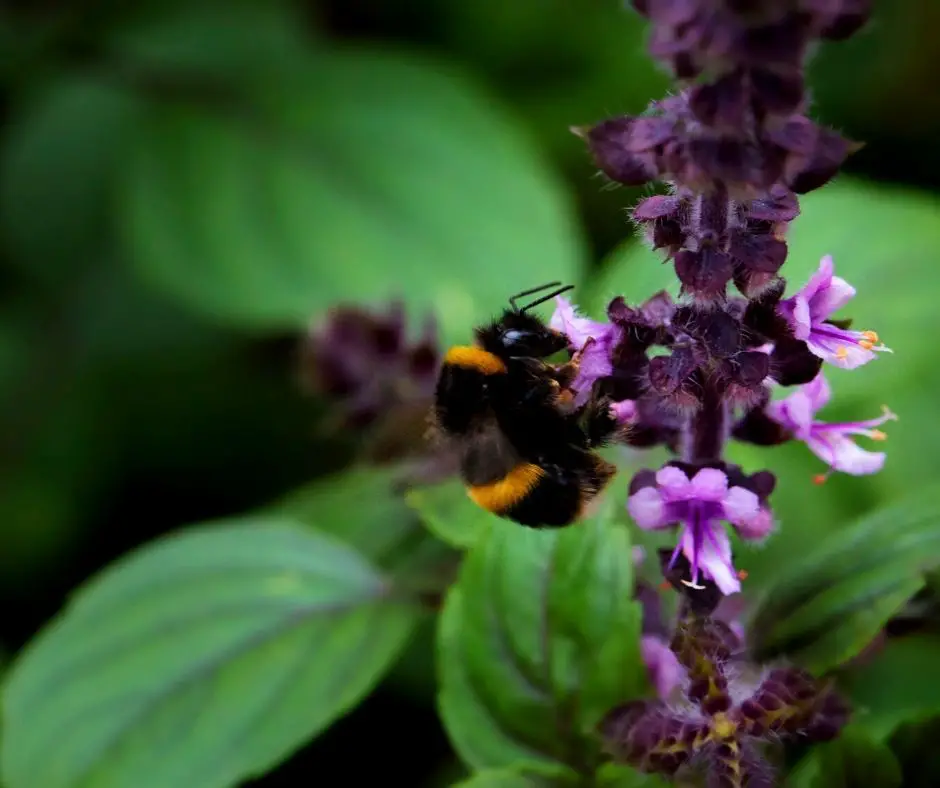
This hybrid basil variety is a perennial in some areas. The plants grow up to 4-feet tall and produce sterile pink flowers as well as having its own unique flavor profile – making it stand out from other varieties of the herb. It is an absolutely stunning show piece in the garden and bees are crazy for it.
African Blue Basil is a sterile variety so seeds are not viable. This variety has to be propagated by cuttings. Cuttings can be taken easy all throughout the year in order to make new plants.
You simple place the cuttings into moist potting soil and sit in the shade until the roots are formed or you can root them in a jar of fresh water until they produce new roots. Once the new plants have grown roots you can then plant them in some rich potting mix.
Cardinal
Growing basil doesn’t have to be just about producing food. Cardinal Basil has beautiful red flowers that add color to the herb garden, and its leaves are delicious with a spicy flavor! It grows up to 30-inches tall and matures in 60 days.
How to Plant Basil
What Zones does Basil do well in?
You can grow Basil in a variety of locations but really thrives in zones 4-10.
When to Plant Basil
You might not have to wait for the last frost date to grow your own basil! You can start them indoors 4-6 weeks before and transplant once they’ve grown big enough.
If you live in a colder climate, be mindful of how chilly it gets at night so that you plant outdoors during warmer months when there is less chance of overnight chills.
If you cannot wait to plant outside and need an indoor fix year round, try planting on windowsill where conditions are more consistent than outside weathers’ temperatures change with seasons
Direct Sowing
After the frost has gone away, you can mix in some seeds with your soil to grow new plants. Just sprinkle them over a prepared bed of dirt and cover it up 1/4-inch deep!
Growing Basil in Containers
Fill your pots with a potting mix that is high-quality. Plant basil seeds and cover the top of it with soil, just to an inch or so deep. Spray water on this every day to keep moist–it needs moisture but not too much!
Sun Requirements
It is important to provide basil plants with plenty of sunlight. It likes 6-8 hours per day, but leaves can scorch in intense light. If it regularly gets hotter than 86 degrees Fahrenheit during the summertime, you should give them partial shade around noon time so they don’t get burned from getting too much sun at such a high temperature!
Soil Requirements
Basil prefers soil pH between 6-7. Ensure the soil is free draining and composted, which will help you maintain a healthy plant!
Spacing
It’s important to plant basil in a way that will allow it the maximum amount of sun. Keep 12-inches between plants and 16-24 inches between rows, depending on what type you have chosen for your garden. Remember that some varieties can get tall so don’t make them next to low growing veggies or they might end up getting shaded out by taller ones!
Transplanting
Once the seedlings sprout and grow to at least 1.5 inches, it is time for them to be transplanted into your garden!
Read more information about how to grow basil
How to Care for Basil
Watering Basil
Growing basil needs regular water. You’ll know your basil is too thirsty if it starts drooping in the heat of the sun, so be sure to regularly check on its moisture levels and give plenty of TLC when needed! Be sure not to over-water though – you don’t want wet leaves getting scorched by a hot summer day’s sunshine!
Give at least 1 inch or 2 inches per week depending on how large your pot is; allowing soil dry out for several days before watering again. Basil also appreciates a good soak rather than frequent watering with just about any kind of liquid fertilizer (organic fertilizers are best).
Protect Basil from Wind
Basil doesn’t like wind and can dry out quickly. A barrier that protects against the wind but lets in enough sun would be best for Basil to grow well and not get too dried out or burnt up by heat from sunlight alone.
How to Prune Basil to Promote New Growth
Basil is notorious for bolting to seed prematurely. This can be because of insufficient watering during a long hot summer. Dead-head the flowers so that you’ll retain more flavor in your leaves, basil lovers! Sometimes the lifespan of this plant is short, but if harvest away – it will give even more back.
By removing the flower heads you will promote new growth and eventually end up with a bushy basil plant that will produce more delicious leaves for you.
How to Fertilize Basil
Basil is one of the easiest plants to care for, and you don’t need fertilizer if its in well-composted soil. But make sure it has plenty of water at all times so that it can produce a good amount leaves! If you find that you basil isn’t producing good size leaves you can give it a bit of a feed with a nitrogen rich fertilizer like fish emulsion.
We use the Liquinox Fish Fertilizer which is 5-1-1 and gives our plants a good boost to their leaf production.
Weeding around Basil
Keeping weeds at bay is important for keeping your basil plants healthy. The best way to do this is by using mulch or other organic materials as a barrier between the herb and invasive grasses that might be trying to grow there too!
Common Problems and Solutions for Growing Basil
When it comes to growing basil there is no shortage of pests and common issues that can trouble you. Growing basil in you garden is one of the most rewarding things you can do and here are tips to make it even easier.
You want to give your basil the best chance for success, so it’s worth taking a few precautions. Keep in mind that sometimes you’ll need some extra help with pests and diseases.
If you feed and water correctly and plant at the right time of year – planting before temperatures are scorching hot or freezing cold will be key – then chances are good your herb garden will thrive all summer long! But occasionally things can go wrong… Here is how to fix them:
- Wilted and Discolored Leaves – Basil needs a fair amount of nitrogen to flourish. If your leaves are wilting or turning brown, it may be time for you give them some help with liquid fertilizer which should provide the nutrients they need.
- Stunted Growth – This is often a sign that basil was planted too early and it suffered in the cold. It could also be due to lack of nutrients.
- White spots on leaves – This can be a sign of too much light. Basil loves sun, but not so much that it might create white areas and yellowing when there is enough daylight hours for the plant to grow in partial shade or under trees if you have any nearby
Protecting your Growing Basil Plants From Aphids
Aphids come in all shapes and sizes, but they have a lot of the same common feeding habits. If you wait too long to spot them on your basil plants, then it will be much harder for you to get rid of them because they can reproduce so quickly! One way that I like is spraying water at aphids when I find one with my plant sprayer.
You should also use neem oil as an insect repellant since it starts making your basil unattractive after just two weeks where even more bugs won’t want anything to do with this pest infested plant!
Neem oil is best for long-term pest prevention, but it can take some time to work. I’ve found that mixing a little organic pyrethrum with the neem helps provide an instant knockdown effect while also prolonging the effects of this natural insect repellent.
Leaf Roller
The leaf roller is probably the insect I have come across most often with basil. The moths like to lay their eggs on the underside of basil leaves, and you can see them crawling along plants looking for a spot or they may even be visibly laid out in little white dots when you notice that some leaves are curling inward slightly because then there’s an egg cocooned by using one side as support.
If you have a light infestation, pick off the impacted leaves. Make sure to check behind any leaf that you might eat because I once nearly placed an Asian beetle in my pesto!
Cercospora Leaf Spot
This fungus attacks leaves, resulting in a dark leaf spot with a white center. Avoid overhead watering and give plants plenty of room to grow. Remove infected leaves immediately, or the infection will spread quickly!
Downy Mildew
This disease causes yellowing on the upper side of growing basil leaves and gray spores under them. Give plants plenty of space, avoid overhead watering if you struggle with this disease, rotate your plants every now and then to help eliminate it from showing up again in other parts of your garden. There is no cure for downy mildew but there’s a new variety called ‘Amazel’ that resists it so far.
Fusarium Wilt
The dark brown stem canker that eventually leads to the death of leaves, as well as a newcomer to growing basil; Fusarium wilt is something you need to know about. There’s no cure for it so preventing its occurrence needs your full attention! Use certified seeds and pick resistant varieties like ‘Nufar’. Watering should be done on soil instead of plants while giving them plenty of room- toss any infected plant.
Gray Mold
The symptoms of this disease are gray, soft spots on leaves which may or not be covered in fungus. Eventually plants will wither and die. This is caused by water mist, rain and irrigation including the fusarium family (spreading).
To avoid exposure to these types of diseases plant basil plants with plenty of space between them for air circulation as well as mulching at least 6 inches deep around their bases can help too!
If your infestation has gotten out of hand you’ll want to look into copper fungicides that have been shown effective against blight when used regularly over time due to its ability kill spores before they germinate within a leaf’s tissues
Root Rot
Root rot is a fungal disease that can eventually kill your plants. There are several steps you can take to prevent root diseases from happening, such as using clean tools and soil when planting new crops or keeping the plant’s roots cool and watered properly if they already have the infection.
Slugs and Snails
Slugs are a pet peeve for gardeners. They munch on the leaves of plants, and if you see something nibbling around your basil plant, they’re likely to be slugs. You can hand pick them or use crushed oyster shells as an organic defense against these slimy creatures!
Cutworms
Cutworms are pests that like to snack on plants during dawn, dusk and cloudy days. They chew through plant stems at the base. You can use a plant collar or hand picking to keep them under control. Merely applying diatomaceous earth around your garden will also do wonders for controlling these pesky worms!
Flea Beetles
If you don’t want to lose your basil plants, then it is important that you take steps against these hopping beetles. You will notice a wilted appearance and tiny holes in the leaves of your plant if they are present. A few simple preventative measures include keeping weeds at bay and covering young growing basil plants with row covers. Tilling up the soil before fall can help get rid any developing larvae as well which means more delicious food for us!
Japanese Beetles
Japanese beetles are insects that can be found in the United States, they measure about 1/2 inch long and have copper backs. They attack plant life in groups which is a dangerous problem because it quickly decimates nearby plants if left unchecked for too long of time.
The best way to address this issue would be to take them off by hand when you see them near your plants or use row covers as an extra security precaution during late spring and early summer months. You could also help reduce populations with neem oil applications at intervals over several weeks while employing traps as well!
Leafminers
Unfortunately, this little critter can be really destructive. They burrow tunnels throughout the leaves of basil plants and leave behind trails that fungi or bacteria could get inside; which is bad news for your garden! To stop them from doing more damage to your plantings you should try squeezing their tunnel out until they pop back up again so hopefully any larvae will come with it too.
You might also want to cover all those holes in the ground where these insects like to hangout using row covers and sticky traps while spraying neem oil every day if needed- we don’t need anymore trouble than we already have down there thanks very much indeed.
Companion Plants for Basil
Growing basil and tomatoes in your garden is a great idea. The tomato plants will get extra flavor from the basil, while the pest-repelling qualities of this herb make sure that they’re safe to grow together!
When you plant your tomato seedlings, scatter basil seeds around the plants and cover lightly with soil. The beauty of this method is by the time you plant tomatoes, it’s warm enough for basil- so when they’re watered there are both getting what they need! If only planting one thing at a time sounds too daunting to get started in gardening; try starting small as all gardens start from their roots up and if that means growing some herbs while waiting on those little greenies to grow into big juicy fruit…well then we hope our suggestion will help ya out!
Come time for harvesting your tomatoes and basil you can make a delicious Caprese salad. There is really nothing better than having one of these fresh out of the garden.
The best plants to pair basil with are:
| Best Companion Plants | Worst Companion Plants |
| Tomatoes | Rue |
| Peppers | Snap Beans |
| Beets | Cucumber |
| Oregano | Anise |
| Marigolds | |
| Beans | |
| Asparagus | |
| Petunias | |
How to Harvest and Use Basil
Saving Basil Seeds
To ensure that you get a variety of seeds, when seeding basil keep the different varieties as far apart as you can. When harvesting your seed pods it is best to wait until they have fully matured before snipping them from their stems and placing in paper bags (pale brown color). Allow for about 5-10 days after harvest time before shaking the bag vigorously so as to loosen any clinging seeds within.
Basil seeds might not just be a great way to start new plants, but they can also make for an excellent snack! You can use them anywhere you would have used chia seeds.
Harvesting and Storing Basil Leaves
In order to get the most out of your basil leaves, harvest them as often as you can. Be sure not to wait too long before harvesting because it won’t last for very long! The best way is tearing rather than cutting since they will blacken easily if using a knife and aren’t great with storage in any case.
Keep fresh leaves stored for only short periods in plastic bags at room temperature or freeze whole leaves packed tightly into freezer containers such as ice cube trays – then store these cubes individually wrapped well-labelled (by month) in sealable polythene bags until needed reducing wastage considerably after thawing from frozen state.
Basil can be used in a variety of dishes, like pesto and pasta. But don’t forget desserts and drinks! In addition to being delicious, basil also helps with stomach issues as well as inflammation-related problems. To get all the benefits you want from this plant, it’s best if you grow some yourself because that way your leaves will always taste fresh when they’re ready for cooking or juicing up those tasty treats.
Growing Basil FAQs
Here is our answers to some of the most commonly asked questions about growing basil.
Is it better to grow basil inside or outside?
You can grow Basil indoors or outdoors. It really doesn’t matter because Basil is one of the few that can grow in both situations. If you are growing indoors make sure to water less that you would outdoors.
Does basil grow well in pots?
Basil grows very well in pots. Just make sure to give it some well draining but nutrient dense potting mix when growing basil in containers and choose the proper pot size as to give your basil plenty of room.
How long will a basil plant live?
Basil can survive for up to two years before replanting in warm climates is necessary. An indoor basil plant with full sun and steady warm temperatures can last longer as well. Basil plants are a warm season crop and suffer with sensitivity to cold weather and frost.
If you like this article about growing Basil, please share it on social media and with friends. For all the latest recipes, container gardening tips and growing guides subscribe to our newsletter in sidebar.
Also, check out our article on What are the best herbs to grow? or How to prepare your herb bed for winter!
Be sure to Like us on Facebook and Follow us on Instagram, Twitter, and Pinterest!
